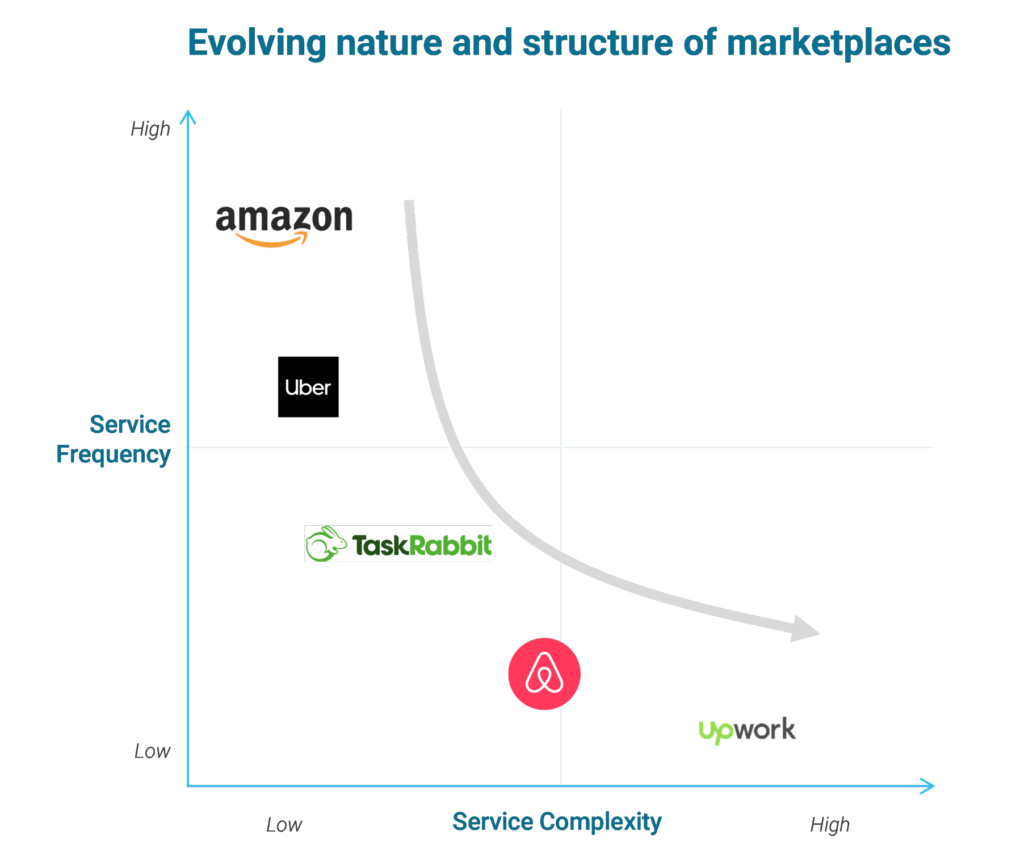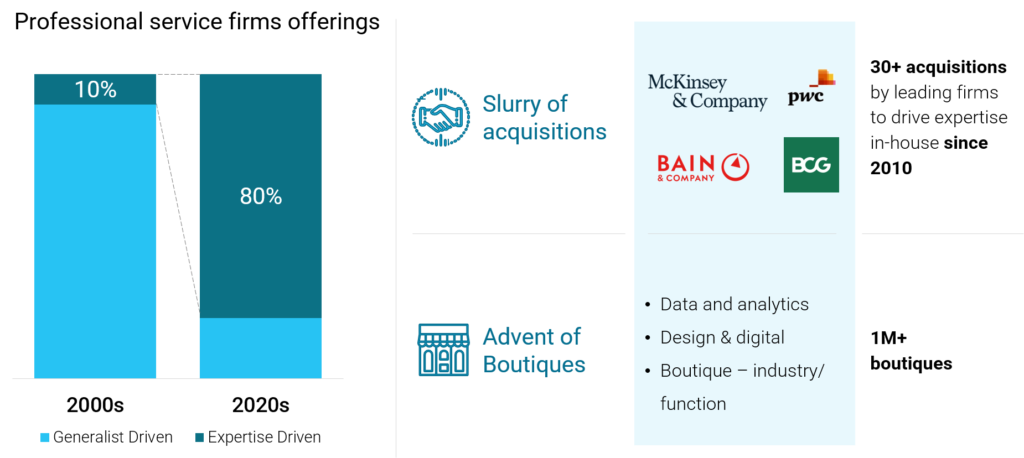The year 2020/21 will go down in the history as a pivotal moment in everything we experienced, our reaction, and the collective resistance. It gave us a chance to think and do things differently. Individuals and businesses were forced to take a step back and figure out a survival plan. The definition of work pivoted. Technology platforms accelerated at an unimaginable pace; and traditional businesses moved at breakneck pace to materialize tech transformations. However, the workforce was caught unawares and had to quickly adapt in an environment of cost savings and remote set-ups.
Workforce adaptability at the organizational level begets foundational change management.
- Embedding technology in the ways work gets done e.g., video conferencing, collaboration tools, etc.
- Remodeling the leadership and management culture with remote/ hybrid set-ups becoming the new normal
- Embracing dynamic workforce to ramp-up/ ramp-down critical functions
However, these are not the trends that emerged overnight. The innovation curve in the industry started to bend around a decade ago. Collaboration tools experienced innovation storm 10 years ago when accidentally built products like Slack challenged the goliaths namely Microsoft and Google. The productivity tech environment laid the foundational work to enable complex team collaboration ushering wave of application stack further enabling online collaboration, project management, and other productivity-first technologies.
Akin to other sectors and industries, with growing technologies, the on-demand economy surged. Platforms of every nature and type sprung up.

Tech developments have enabled building and scaling up of complex platforms wherein entrepreneurs started building higher operational control and process standardizations to tap the valuable and highly fragmented markets. One of the key niches that emerged to support the current state of work and build the future of work was high-skills digital talent platforms and the ancillary supporting technologies. These platforms are effectively providing cost efficiencies, access to robust supply infrastructure, and a dynamic way of engaging on-demand talent. In 2009, around 80 such companies existed attracting $180 million investments that hyper grew to 330 companies garnering $1.9 billion investments in 2019 to drive adoption and growth (The Future of Work, Harvard Business School) .
The increasing adoption of these platforms and the penetration of high-skills workers across the globe (e.g., 33%+ in US, 11% in EU, 7% in Australia, <0.1% in GCC) is a result of intertwined factors supporting each other via a positive feedback loop.
- Organizations building competitive edge: Today’s need for rapid digitization mandates leveraging a myriad set of functional capabilities. Organizations leverage high-skills platform to pull in relevant skills on-demand realizing the objectives within tight deadlines. This nimble approach is gaining traction and provides more confidence to next-age executives who want to create long lasting impact in their respective organizations.
- Enhanced supply infrastructure and capabilities on-demand: With increased penetration of high-skills gig workers, improved curation processes, and viral outreach to such strategic skills, supply numbers – one of the critical moats – have ballooned providing a positive push to industry growth.
- Advent of boutique specialized firms: Expertise-first approach has taken the industry by storm over the last decade as the large firms (e.g., McKinsey, PwC) led 30+ acquisitions to drive in-house expertise. Moreover, the industry saw a sudden surge in number of boutiques (1m+ globally, 350K+ in Europe & Asia) with niche expertise in a) data and analytics, b) design and digital, and c) specific industry and functions. The lean and mean set-up of such boutiques are capturing the market aggressively and exploring various growth channels including high-skills platforms to scale and service the demand with deep capabilities advantage.

- Shrinking core workforce in driving efficiencies: Organizations are steadily keeping strategic positions in-house with execution force pulled-in on as-and-when need basis. This shift also enables organization to focus on building effective cross-functional leaders – pertinent in the digital agile age.
- Era of remote/ hybrid working: Decentralization of the workforce has begun. Organizations are not restricted to finding a talent and bringing them to the city – the world is not talent hunting ground if sufficient time zone(s) overlaps are met. Overseas hiring also mandates organizations to explore contractual way of building the workforce wherein such platforms come handy.
The increasing reliance on high-skills platform gives various advantages to organizations.
- Workforce flexibility: Organizations evolve with time and so do the offerings. However, evolution of the workforce at the same pace gets harder and hinders progress. The necessary workforce flexibility enables organizations to evolve and rather leapfrog the progress in critical initiatives that need specific strategic & operational expertise. Over 60% of the Fortune 500 companies have embraced the high-skills on-demand model providing much needed push to the prioritized initiatives.
- Augment, learn and scale opportunities: Organizations understand that all capabilities and skills cannot be grown in-house. The cross-staffing opportunities enable organizations to train the core workforce with specialized experts whilst getting the work done. This further boosts workforce morale as the employees see clear growth and investments put forth by their organization.
- Rapid innovation trials: Piloting large number of innovative initiatives is every business leader’s dream. However, the traditional means can prove to be extremely expensive. This is where the high-skills platform come in, enabling such experiments by reducing the cost of failure. Over 30% of on-demand staffing needs are driven by new ventures and start-ups that want to ship fast iterations of respective product & services.
The high-skills digital platforms as a concept are in its infancy in the Middle East. However, it is experiencing a significant pull from organizations and new age executives that want to pilot such novel way of scaling talent requirements, creating a gigantic domino effect. We believe that the market is amid supply consolidation and pilot mode and is poised for an accelerated on-demand high-skills phenomenon the way other markets matured in the last 5 years or so.
About StrategyConnect
StrategyConnect is an agile technology platform that enables organizations execute strategic & tech projects via smart talent management and on-demand marketplace. Our supply network comes from leading professional services firms and tech giants. Our clients represent a pool of relentless high impact executives willing to go the extra mile in delivering value and fundamental business shifts. StrategyConnect’s proprietary subscription platform is used by leading specialized boutiques in managing their complex workflows. Visit strategyconnect.co for more details.




